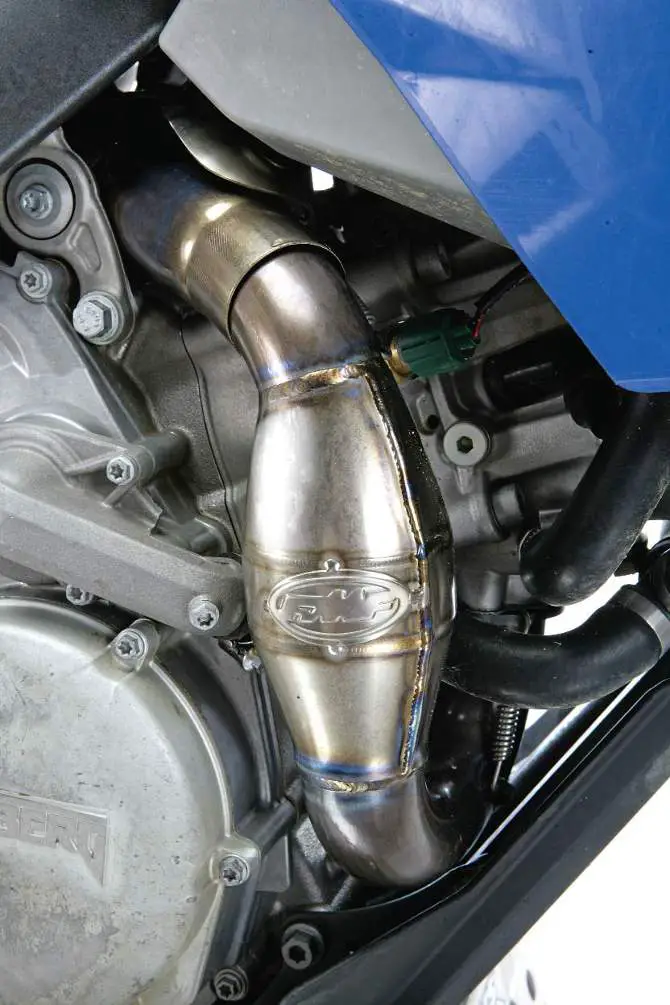TEN THINGS YOU NEED TO KNOW ABOUT HEAD PIPES

(1) Head of the game. The name “head pipe” or “header” for short refers to the section of the exhaust pipe that connects to the cylinder head, which is why two-strokes don’t have head pipes. Most dirt bike head pipes are stainless steel or titanium. Regardless of the material, the physical dimensions and horsepower are almost always identical within a brand’s systems.
(2) Construction. Head pipes start life as straight tubing that is swaged or tapered and bent in a mandrel bending tool to form as many degrees of arc as necessary. Multiple-diameter headers can also be stair-stepped, which requires welding.
(3) Performance tuning. Building a powerful exhaust system isn’t about going as large as possible on the tubing, because exhaust gases are released in spurts from the reciprocating engine’s cycle, not in one single blast. Tuners choose pipe diameters to time the pipe’s resonating pulses with the opening and closing of the exhaust valves. Since dirt bikes need to run across a relatively broad rpm range, it’s a tricky balance to get the right specs. A cam, throttle body or piston change can change the exhaust requirements and optimum head pipe dimensions.
(4) Exhaust port. Have you ever wondered why many aftermarket head pipes are fastened to the cylinder head with a complicated assortment of slip-fit flanges, springs, hooks and nuts while the stocker was a simple bolt-on? It’s not a conspiracy to frustrate you; it’s for performance. It allows the aftermarket company to match the inlet of the head pipe with the exhaust port.
(5) U-bend. Most modern dirt bike head pipes have a U-bend after the exhaust port, although the 2009-2012 CRF450 had a more gradual bend while the 2010-2013 YZ450F was a corkscrew. Both companies have since simplified their bends. Since motorcycles are compact, exhaust designers have to be creative with head pipes when calculating the system’s overall tuned length. Some head pipes swoop way out (Honda) and some tuck in tight (Yamaha). Creative bends can be power-enhancing, help with achieving tuned length and centralize the mass of the bike. The head pipe shape, however, must not be so exotic as to expose the head pipe to too much damage in a crash.
(6) Damage control. You might be surprised by how well a heavily dinged or smashed head pipe can be repaired with the application of heat and air pressure. It’s like blowing into a crumpled plastic water bottle and costs much less than a new unit. There are shops that specialize in fixing broken pipes, most notably Pacific Crest Pipe Repair (www.piperepair.com). It costs about $60 to make a dented pipe look new.
(7) Resonance chambers. Resonance chambers may look complex, but they are nothing more than an empty canister welded to the head pipe. A small 1/2-inch hole joins the two. Although they can add power, they are mostly used to reduce sound. Some companies use resonance chambers selectively, and many use them primarily for tuning bottom-end power.
(8) Head pipe versus slip-on. Modern head pipe design is light years ahead of where it was back in the Honda XR400 days. New bikes have titanium head pipes, resonance chambers and tapers. These stock head pipes make the less expensive slip-on exhaust systems (which are just the muffler and mid-pipe), more attractive to riders trying to save money. There are bikes that work exceptionally well with slip-on pipes and others that need a complete system to get the maximum benefit.
(9) Head pipe care. When installing an exhaust system, leave the bolts, brackets and head pipe loose until the muffler and mid-pipe are fitted. Don’t force a head pipe into place. It’s smart to loosen all the attachment points and refit the system once a month. Even though stainless steel and Ti are rustproof, they can corrode. After washing your bike, it is best to run the engine for a few minutes to evaporate leftover water. Many mechanics spray their pipes with Maxima MPPL to form a protective film.(it burns off when you start the bike.)
(10) Head pipe accessories. In the high-tech world of EFI tuning, you will often see bikes with a bung welded onto the head pipe. This bunghole is used to attach an oxygen sensor for fuel mapping. Some pipe manufacturers offer pipes with the bung already attached. Most stock pipes come with heat shields, but aftermarket pipes do not. Companies like E-line sell carbon fiber guards that can be clamped on for both crash protection and rider protection (www.elineaccessories.com).






Comments are closed.